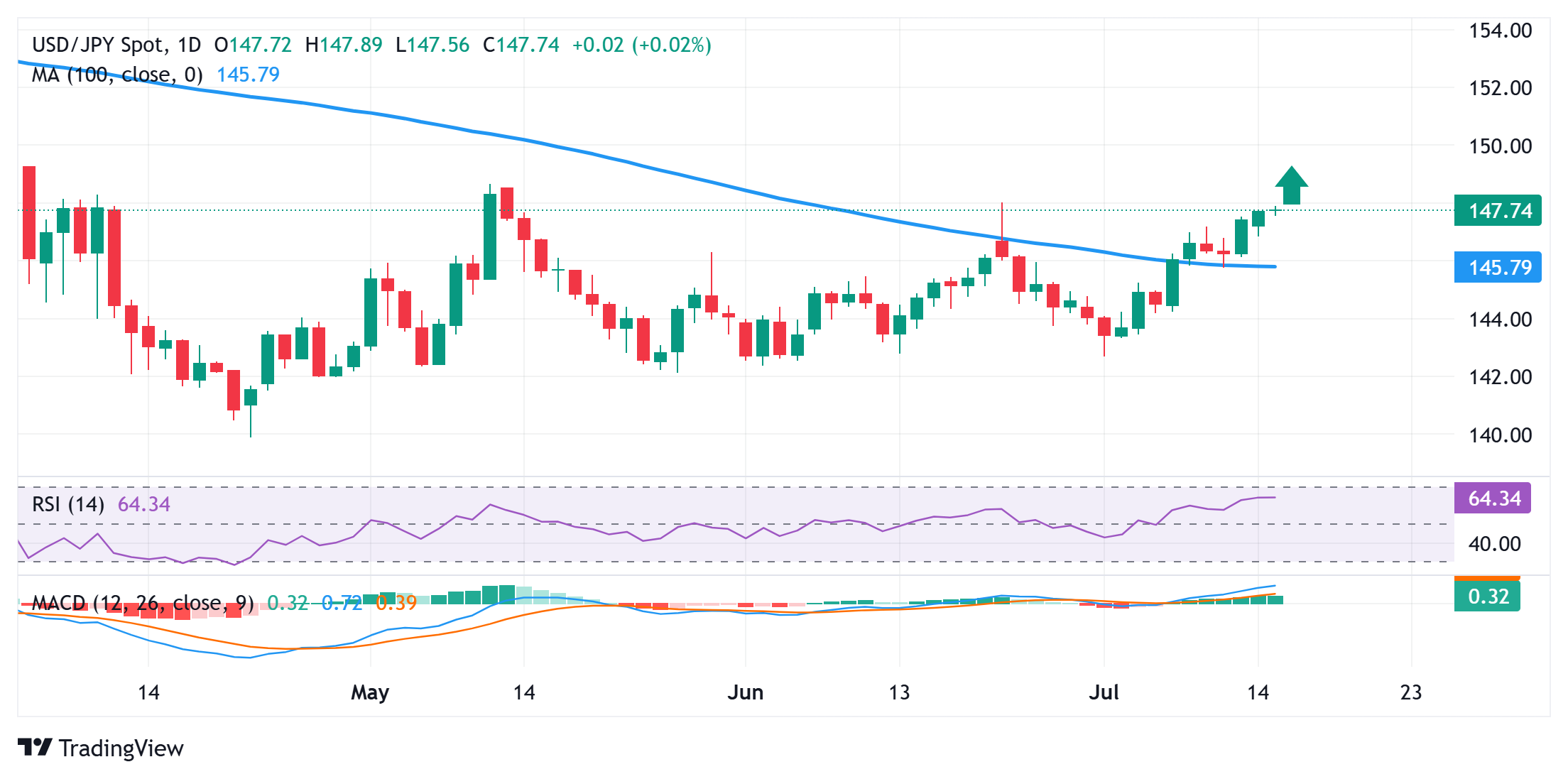Created
: 2025.07.15














![]() 2025.07.15 11:27
2025.07.15 11:27
The Japanese Yen (JPY) struggles near a three-week low against its American counterpart during the Asian session on Tuesday and seems vulnerable to prolonging a two-week-old downtrend. US President Donald Trump showed willingness to engage in trade negotiations, fueling hopes for a US-Japan deal before the August 1 deadline and lending some support to the JPY. Meanwhile, the optimism boosts investors' appetite for riskier assets and acts as a headwind for the safe-haven JPY.
Furthermore, bets that the Bank of Japan (BoJ) would keep interest rates low for longer than it wants amid concerns about the economic fallout from higher US tariffs contribute to capping the JPY. Apart from this, political uncertainty ahead of Japan's upper house elections on July 20 might hold back the JPY bulls from placing aggressive bets. Traders also seem reluctant ahead of the US consumer inflation figures, which will provide some meaningful impetus to the US Dollar (USD) and the USD/JPY pair.

The recent breakout through the 100-day Simple Moving Average (SMA) and a subsequent strength beyond the 147.00 mark was seen as a key trigger for the USD/JPY bulls. Moreover, oscillators on the daily chart have been gaining positive traction and are still away from being in the overbought territory. This, in turn, suggests that the path of least resistance for spot prices remains to the upside and backs the case for an extension of a two-week-old uptrend. From current levels, the June swing high, around the 148.00 mark, could act as an immediate hurdle, above which the currency pair could test the 148.65 region (May swing high) before aiming to reclaim the 149.00 round figure.
On the flip side, any meaningful corrective slide could be seen as a buying opportunity near the 147.20-147.15 region. This is closely followed by the 147.00 mark, below which the USD/JPY pair could accelerate the fall towards the 146.60-146.55 region en route to the 146.00 round figure and the 100-day SMA, currently pegged near the 145.80 region. The latter should act as a key pivotal point and a convincing break below might shift the near-term bias in favor of bearish traders, paving the way for a decline towards the 145.50-145.45 area en route to the 145.00 psychological mark.
The Japanese Yen (JPY) is one of the world's most traded currencies. Its value is broadly determined by the performance of the Japanese economy, but more specifically by the Bank of Japan's policy, the differential between Japanese and US bond yields, or risk sentiment among traders, among other factors.
One of the Bank of Japan's mandates is currency control, so its moves are key for the Yen. The BoJ has directly intervened in currency markets sometimes, generally to lower the value of the Yen, although it refrains from doing it often due to political concerns of its main trading partners. The BoJ ultra-loose monetary policy between 2013 and 2024 caused the Yen to depreciate against its main currency peers due to an increasing policy divergence between the Bank of Japan and other main central banks. More recently, the gradually unwinding of this ultra-loose policy has given some support to the Yen.
Over the last decade, the BoJ's stance of sticking to ultra-loose monetary policy has led to a widening policy divergence with other central banks, particularly with the US Federal Reserve. This supported a widening of the differential between the 10-year US and Japanese bonds, which favored the US Dollar against the Japanese Yen. The BoJ decision in 2024 to gradually abandon the ultra-loose policy, coupled with interest-rate cuts in other major central banks, is narrowing this differential.
The Japanese Yen is often seen as a safe-haven investment. This means that in times of market stress, investors are more likely to put their money in the Japanese currency due to its supposed reliability and stability. Turbulent times are likely to strengthen the Yen's value against other currencies seen as more risky to invest in.
![]()
Created
: 2025.07.15
![]()
Last updated
: 2025.07.15

FXStreet is a forex information website, delivering market analysis and news articles 24/7.
It features a number of articles contributed by well-known analysts, in addition to the ones by its editorial team.
Founded in 2000 by Francesc Riverola, a Spanish economist, it has grown to become a world-renowned information website.
We hope you find this article useful. Any comments or suggestions will be greatly appreciated.
We are also looking for writers with extensive experience in forex and crypto to join us.
please contact us at [email protected].
Disclaimer:
All information and content provided on this website is provided for informational purposes only and is not intended to solicit any investment. Although all efforts are made in order to ensure that the information is correct, no guarantee is provided for the accuracy of any content on this website. Any decision made shall be the responsibility of the investor and Myforex does not take any responsibility whatsoever regarding the use of any information provided herein.
The content provided on this website belongs to Myforex and, where stated, the relevant licensors. All rights are reserved by Myforex and the relevant licensors, and no content of this website, whether in full or in part, shall be copied or displayed elsewhere without the explicit written permission of the relevant copyright holder. If you wish to use any part of the content provided on this website, please ensure that you contact Myforex.
Myforex uses cookies to improve the convenience and functionality of this website. This website may include cookies not only by us but also by third parties (advertisers, log analysts, etc.) for the purpose of tracking the activities of users. Cookie policy